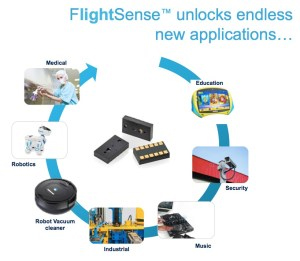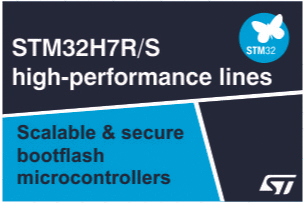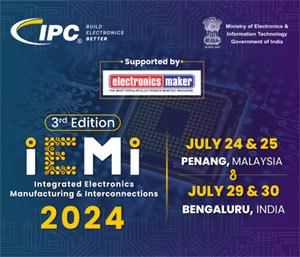 The world’s first Time-of-Flight (ToF) proximity sensor, introduced by ST in 2013, offered unprecedented accuracy and reliability in measuring the distance between the sensor and a single object. This innovative sensor and next-generation devices introduced later, precisely measured the time a photon took to travel to the nearest object and reflect back to the sensor. Today, ST’s most sophisticated new FlightSense Time-of-Flight sensor adds an optical lens that improves its performance yet again and helps it see and determine proximity to multiple objects. The new ToF sensor can also detect multiple objects. It is ideal for presence detection where it can protect information or shut down a system to save energy. It also fits robotics, drones, IoT, and wearable applications.
The world’s first Time-of-Flight (ToF) proximity sensor, introduced by ST in 2013, offered unprecedented accuracy and reliability in measuring the distance between the sensor and a single object. This innovative sensor and next-generation devices introduced later, precisely measured the time a photon took to travel to the nearest object and reflect back to the sensor. Today, ST’s most sophisticated new FlightSense Time-of-Flight sensor adds an optical lens that improves its performance yet again and helps it see and determine proximity to multiple objects. The new ToF sensor can also detect multiple objects. It is ideal for presence detection where it can protect information or shut down a system to save energy. It also fits robotics, drones, IoT, and wearable applications.
 The tiny sensor, measuring less than 20mm^2 (4.9 x 2.5 x 1.56mm), contains an invisible light source — a 940nm Vertical Cavity Surface Emitting Laser (VCSEL); a processing core; a single-photon avalanche diode (SPAD) to detect returning photons; and the optical lens to boost the detection rate. Together this tiny marvel has a maximum ranging capability beyond 4.5 meters (~15 ft) and performs a proximity measurement in as little as 5ms–twice as fast as earlier-generation proximity sensors, making it suitable for camera autofocus cameras and moving it closer to automotive safety applications.
The tiny sensor, measuring less than 20mm^2 (4.9 x 2.5 x 1.56mm), contains an invisible light source — a 940nm Vertical Cavity Surface Emitting Laser (VCSEL); a processing core; a single-photon avalanche diode (SPAD) to detect returning photons; and the optical lens to boost the detection rate. Together this tiny marvel has a maximum ranging capability beyond 4.5 meters (~15 ft) and performs a proximity measurement in as little as 5ms–twice as fast as earlier-generation proximity sensors, making it suitable for camera autofocus cameras and moving it closer to automotive safety applications.
New silicon-level architectures steal the show in the new ToF proximity sensor. At the silicon level, the new architecture supports multi-target detection; cover-glass crosstalk immunity at longer distances, and programmable multi-zone scanning. This innovative architecture enables the sensor to detect multiple targets within the scene while also allowing manufacturers to sub-divide the SPAD sensing matrix into custom-defined zones. These small zones can then provide spatial ranging information that the customer application can use for dual-camera computation in stereoscopy as well as simple depth-map use cases.
Much like the earlier generation FlightSense proximity sensors, which have already shipped several hundred units in smartphones and other applications, the new Time-of-Flight sensors are poised to create a whole range of new products and applications.






